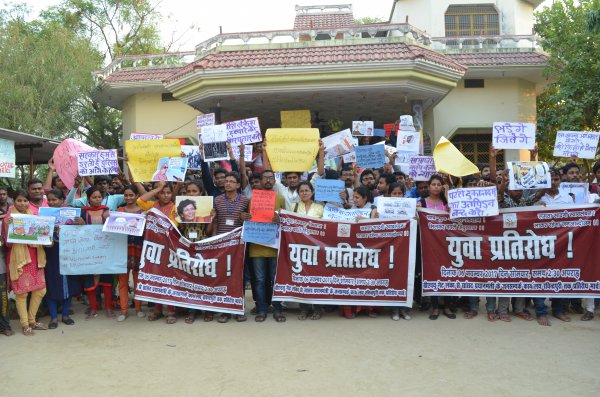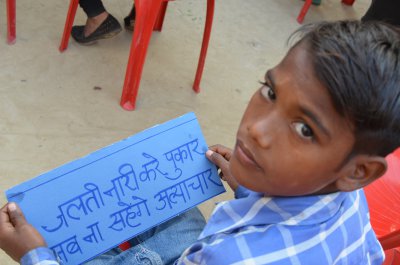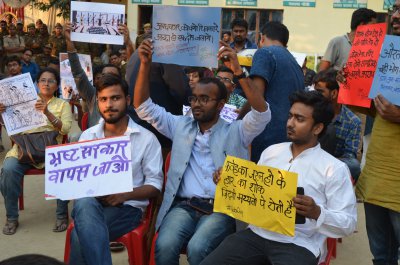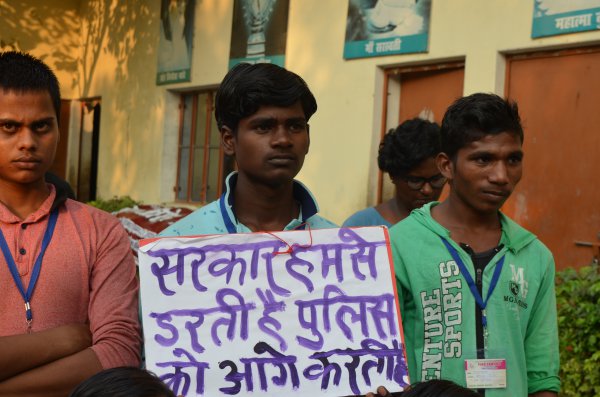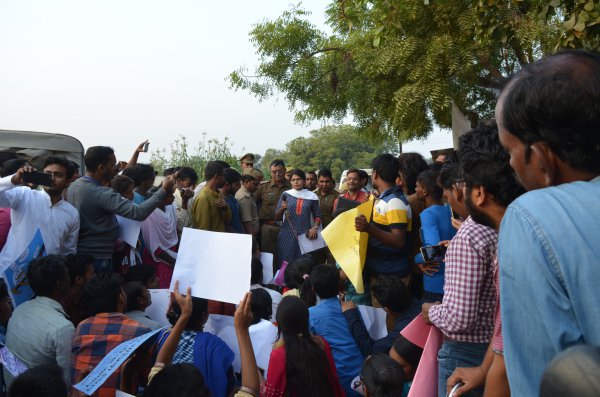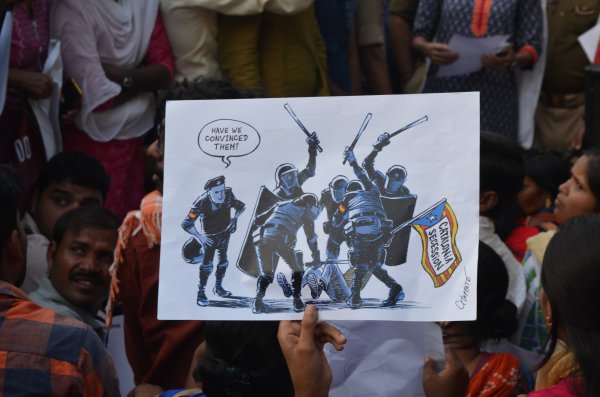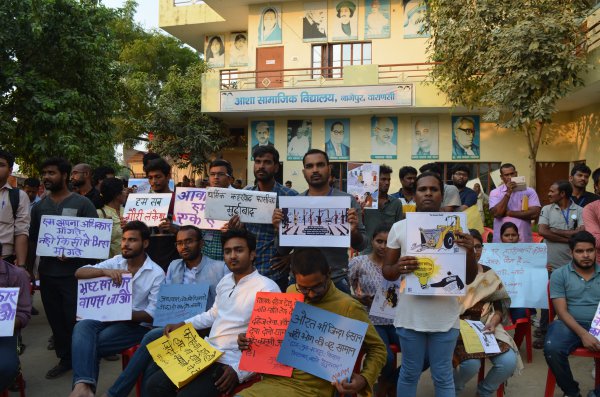Image Courtesy: All images are by Yogesh S
The National Alliance of People’s Movements (NAPM) organised a Yuva Samvad (A dialogue with the youth) from 3 to 6 November 2017. This three-day long congregation hosted youth activists, involved in various movements, from across the country. Youth activists from the Narmada Bachao Andolan, from farmers’ movements, representatives of people’s movements in Assam, trade unions, child right activists, women’s organisations, queer and transgender activists, lawyers, artists, and cultural activists, all came together to exchange their experiences of being involved in these movements, particularly focussing on the last three years.
Lok Samiti Ashram, a non-profit and a non-religious people’s group founded by Jai Prakash Narayan, hosted Yuva Samvad in Nagepur Village in Varanasi. The Ashram also provided lodging and meals to all the 120 youth activists in attendance. Nagepur is one of the villages adopted by Prime Minister Narendra Modi under the Saansad Adarsh Gram Yojana (SAGY). Yuva Samvad aimed at discussing, reflecting, and critically analysing the policies of the current government in power. The Narendra Modi government is increasingly coming under fire for its blatant efforts to crush any dissenting voices and to penalise any form of criticism of its functioning. Thus, Yuva Samvad, a congregation of voices of dissent from across the country, taking place in a village adopted by Narendra Modi, was a symbolic protest in itself.
On the first day, the activists participating in the Samvad were introduced to each other. Activists coming from various castes, class, gender, ethnic and linguistic backgrounds interacted with each other and learnt about the composition of the Samvad. Once the ice was broken and the participants were familiar with each other, it was time to know fellow comrades and activists from their states. Participants from different states assembled in small groups and discussed issuesthat they were working on and the challenges that their movements faced. At the end of the day, two participants from one state each briefly presented the common issues addressed by different groups in their respective states. The particpants made the presentations in their own regional languages, which was then translated into both English and Hindi by volunteers working as translators and interpreters.
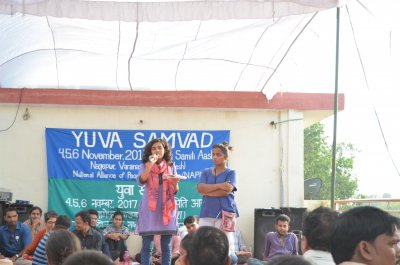
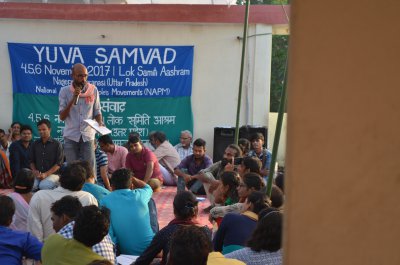
The activists were divided into four groups on the second day. In order to give a structure to the dialogue, four broad themes were laid out:
Theme 1:Development Politics.
Theme 2:Resisting Fascism and Communalism.
Theme 3:Gender, Caste, Minorities Identity and Social Justice.
Theme 4:Education and Employment.
All the four groups discussed these four themes and the discussion was moderated by senior activists and members of various civil society organisations who are working in the four areas under discussion. The discussion was guided by the following questions:
-
What are our ideas and strategies for greater mobilisation among youth in our movements and creating spaces for youth leadership?
-
How do we further democratise participation of youths from diverse identities and backgrounds in social movements?
-
How do we collectively build and strengthen the capacities of young people to address the challenges we are facing?
-
How do we creatively use various tools — such as social media, community media, print and press media etc. — to strengthen our campaigns and counter the dominant corporate media?
-
How do we remain actively connected and build solidarities, both within the specific spheres of our work and also across diverse concerns?
Development has long been the chief promise of the Narendra Modi government. The supporters of the Prime Minister and the ministers of this government defend and justify every questionable action of the government saying it had to be done for the sake of development. what is development? Whose development? And development at what cost? These questions emerged as the common thread among all the four groups. Atrocities on dalits, women, sexual and religious minorities, and adivasis; attack and killings of rationalists and activists like Narendra Dhabolkar, Govind Pansare, M M Kalburgi, and Gauri Lankesh; the adverse and detrimental effects of “development” projects in tribal belts, demonitisation, and GST, all of these were spoken of.
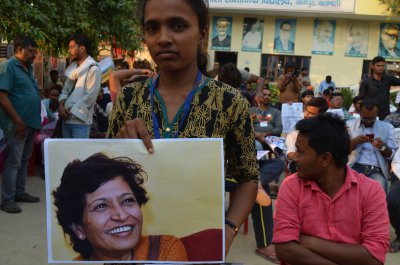
There has been an increase in the recent spate of attacks on fundamental rights guaranteed to the citizens by the Constitution of India. The Constitution guarantees equal rights to every citizen irrespective of their caste, class, gender, race, and ethnicity. Violation of this principle of equality is supposed to be punishable. The participants at the Samvad noted various incidences across the country where the fundamental rights of people had been violated. The nexus of the neo-liberalism, Indian state and the police forces suppress the movements that protest against such violations. The participants acknowledged the need to fight this nexus. Mobilising the youth to actively participate in these movements is of utmost importance. The youth have been the primary target of these neo-liberal forces and religious fundamentalist forces like the RSS. The education system being privatised, for example, has opened the gates for neo-liberal values. The employment market firstly lures the youth through the employment oriented private education, and no thought is given to teaching the students how to understand and question their social realities.
Such early-on conditioning of the youth has become a tool for the State to pre-empt all the avenues of dissent. Social media — like Facebook, Twitter, Whatsapp, Tumblr, Instagram, etc — which is accessed by most of the youth in the country, is being actively used by the fundamentalist groups and the State to gain currency among the youth. Social media is also used to spread hatred towards various minorities and dalits. Recognising this dangerous development, the participants discussed the ways in which they, as activists, could use these spaces to sensitise the youth. Sharing stories, images and writings from the field as widely and regularly as possible; generating a dialogue in both closed and open groups; and most importantly making these posts or writings accessible to those who do not have any access to internet, were some of the suggestions that the participants came up with, when discussing ways to counter the divisive ways in which social media is being used.
Finally, through the workshop, the participants recognised the importance of coming together of all the movements to fight the rising opressive forces. The aim is to fight for a system which is based on the principles of equality. Thus the goal should be to build solidarities between various movements while continueing the work in individual movements addressing specific issues.These solidarities in turn would form a large network of movements, making these movements stronger and enabling them to counter the oppressive forces.
Yuva Samvad ended on 6 November with a cultural protest called Yuva Prathirod. The cultural teams participating in the Samvad had put together a song, a carrion call to the youth in the country to unite in the fight against the present government’s divisive policies. This song was in Hindi, Kannada, Telugu,Tamil, Malayalam, Marathi, and Bangla. The song emphasises the importance of culture as the strongest protest strategy; as a tool of the common people; as a language that breaks all the boundaries; and a language that people of this country understand.
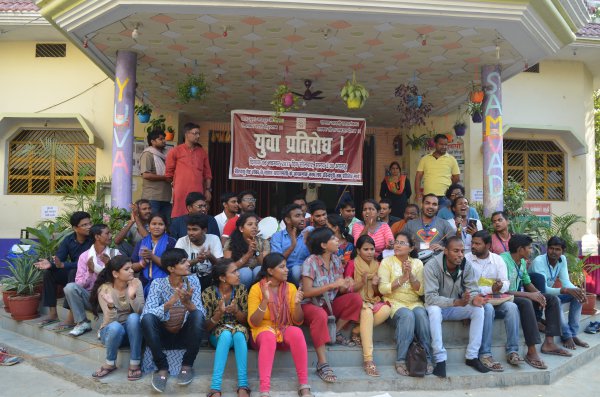
The three days of Yuva Samvad was supposed end with a protest march to the Prime Minister’s regional office in Varanasi. But the elections in Varanasi and intimidation by the police forced the organisers to change the venue of the protest march to Banaras Hindu University (BHU). However, the police —which had anyway occupied half of the venue on 6 November — stopped the rally much before BHU, not even letting the rally take place in Nagepur village, the venue of the Yuva Samvad.
Isha Duhan, Sub-DIvisional Magistrate (SDM) Rajatalab, Varanasi addressed the participants, particularly the agitated BHU students. The SDM promised the students that the enquiry on complaints regarding the university’s functioning and authorities will be strengthened.
It is ironic that a protest march by Yuva Samvad, in which participants had spent three days discussing the increasing number of attempts to silence dissent, was stopped by the police. This experience demonstrated the grave reality of our times and strengthened the participants’ resolve to fight the oppressive state and its instruments.

